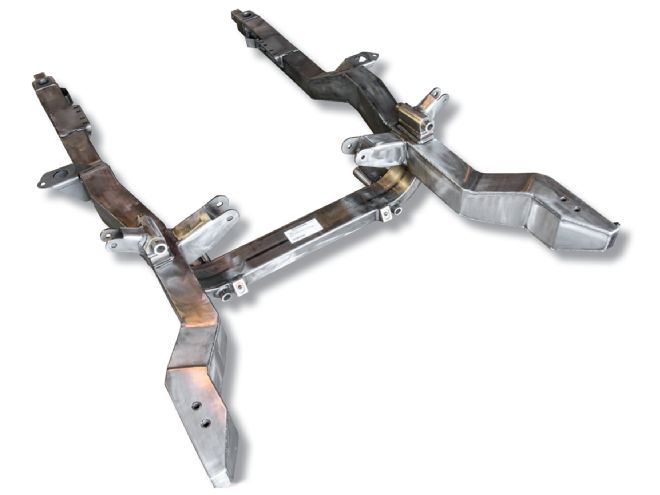
We’ve heard it said that wheels make the car. But if you’re going to log any serious highway miles, then it’s really a car’s suspension that determines if it’s fun or not. Don’t believe us? Well then hop out of your modern, rack-and-pinion-equipped car and hit a mountain highway in a vintage, stock-restored Chevy. What you’ll find is that it looks great but handles like a pig—and not a particularly agile one either.
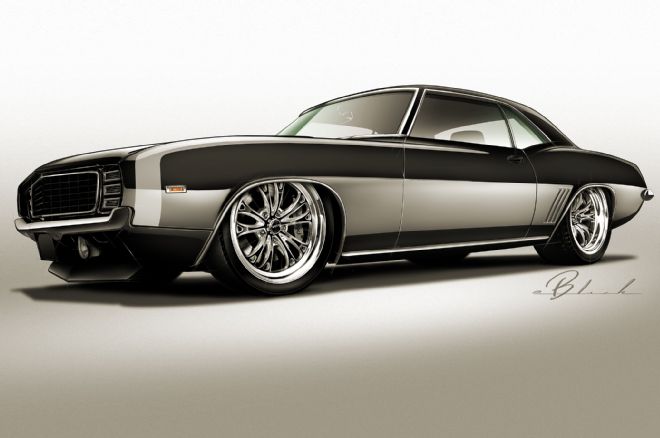
Thanks to the aftermarket, it’s a fairly easy proposition to imbue our classics with modern road manners. One option is to upgrade the parts while still utilizing the stock subframe. Sure, the car will handle much better, but utilizing the factory frame means compromises need to be made. A better, though admittedly more expensive, option is to go with a complete aftermarket subframe. This approach gives better handling since the complementary suspension bits don’t have to work around the design and geometry of the GM frame.
One such system is Chris Alston’s Chassisworks g-Machine subframe. Now, it’s still a direct bolt-in deal, but that’s where any similarity to the factory front suspension ends. The suspension itself was designed on a “clean sheet” of paper, which means it isn’t just a variation of OEM geometry. Using Pro/Engineer software, the engineers at Chassisworks were able to create a modern, technologically advanced, yet reasonably priced, front clip. And while the performance of this subframe is on par with late-model Covette-based systems, it doesn’t force you to run flat-face, high-negative-offset wheels. Prices range from around $4,800 for their “value system” up to $8,500 for their “ultimate Pro Touring system.” But, keep in mind that there are myriad of options available to tailor the subframe to both your needs and your wallet, so you might want to grab a notepad and hit their website.
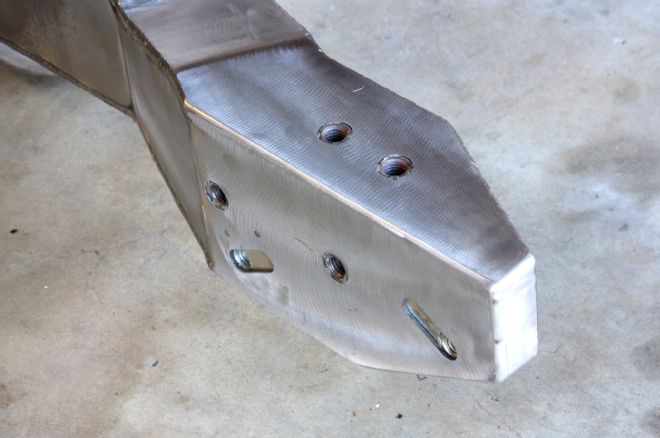
01. OK, so obviously the main player in the front subframe assembly is the subframe itself. The Chassisworks subframe is larger and stronger than other tubular designs on the market. A lot of this is due to the massive 3x4-inch subframe structure at the critical chassis stiffness area from the crossmember rearward through the firewall mounts. The frame also incorporates all the necessary mounting points for items like bumper brackets and core support.
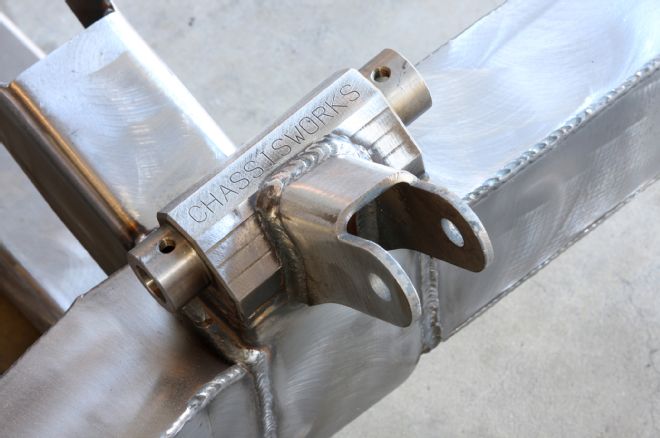
02. The design is completely enclosed, which adds to strength, and each ’rail is assembled from four separate, 12-gauge sheetmetal panels. The ’rail panels are CNC laser-cut and, once the contour bends have been made on their fully automated press, the panels are assembled using positioning features. They explained it as a three-dimension puzzle since the ’rail panels can only be fit together in the absolutely correct shape. Once in place, the four corner seams are welded with a continuous bead to completely bond the joint. The welds are so nice that even though they will sand them smooth (for $375); we think you would be better off spending that cash elsewhere.
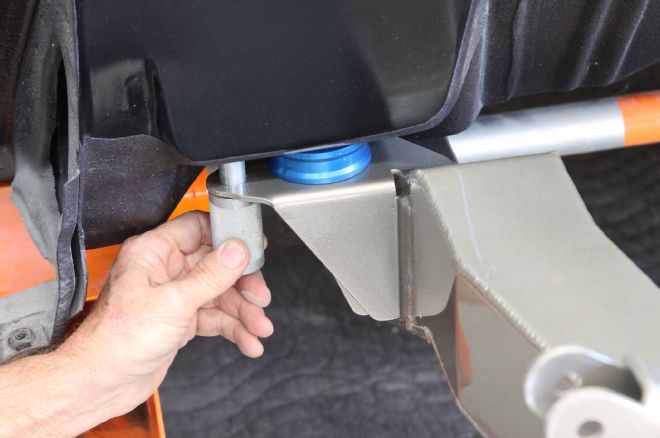
03. Installing the frame under the car was as straightforward as stuffing a stock frame under there. This is due to the alignment holes that duplicate the factory arrangement. Chassisworks also supplies a pair of CNC-machined alignment pins for even greater accuracy. Once both pins were in place we simply tightened down the bolts through our aluminum body bushings (PN 6816). They do offer urethane bushings for those who want to cut down on transmitted vibration a bit, but we sort of like it.
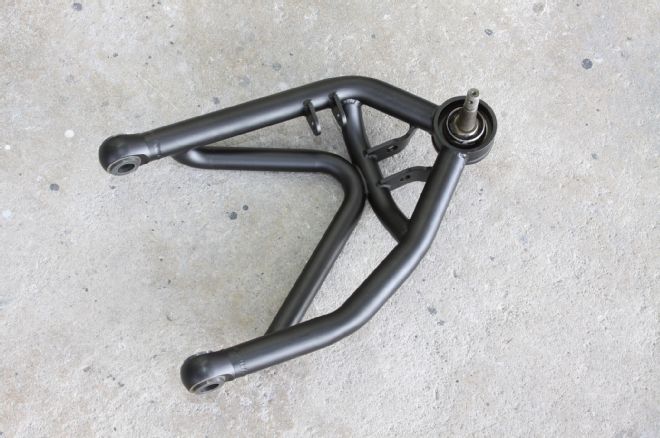
04. Chassisworks’ TIG-welded lower A-arms feature 1.25x0.156-inch wall steel tubing and 1x0.156-inch wall, multi-plane triangulated crossbraces. The CNC-machined weld eyes create a stable bushing housing that inserts into each arm tube and gradually tapers to match the outer tubing diameter. This eliminates fatigue points normally found in other “T”-style tubular bushing-housing joints. The geometry offsets the ball joint forward to improve static positive caster and it also places the shock very close to the spindle in a dropped position for better control. The lower pivot points are spread broadly apart, increasing performance while eliminating the need for secondary strut rods.
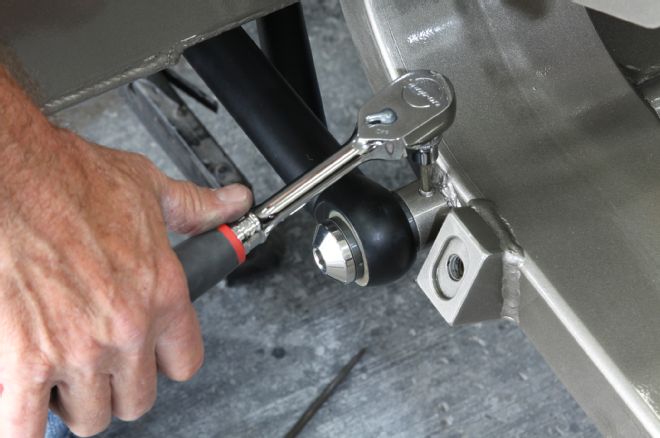
05. The lower arm was then secured to the subframe using the unique pivot-stud hardware. This specially designed Allen-drive, beveled-head pivot stud threads directly into the g-Machine crossmember. The fasteners feature a thread-free 3/4-inch shank for maximum shear strength and have a broad bearing contact surface that reduces wear. There’s also a shoulder on the bolt that ensures the correct amount of bearing preload. The arm is further secured using oval-point set screws. Also, here you can see one of the rack mounts, which uses Chassisworks’ interlocking-slot-tab technology. Self-fixturing female slots in the frame are used to properly locate mounts, which employ corresponding male tabs. They are then fused together using a spray-arc welding process.
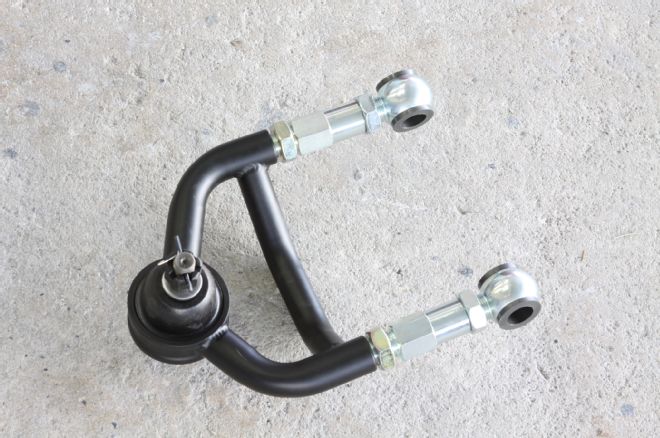
06. The upper arms may not look strong, but they are. Constructed from mandrel-bent, 1x0.156-inch wall steel tubing, with 0.875x0.156-inch wall crossbraces, they are TIG-welded into a triangulated design that is strong and allows for plenty of shock clearance. With the aid of a fixture, the tubes are seated into recessed faces along the ball joint housing to create an interlocking fit. On the geometry side, the arm provides positive caster upon installation by offsetting the ball joint rearward. The pivot bearings are self-lubricated and require little maintenance thanks to minimal linear resistance and zero deflection. And if they do wear, the arms are easily rebuildable.
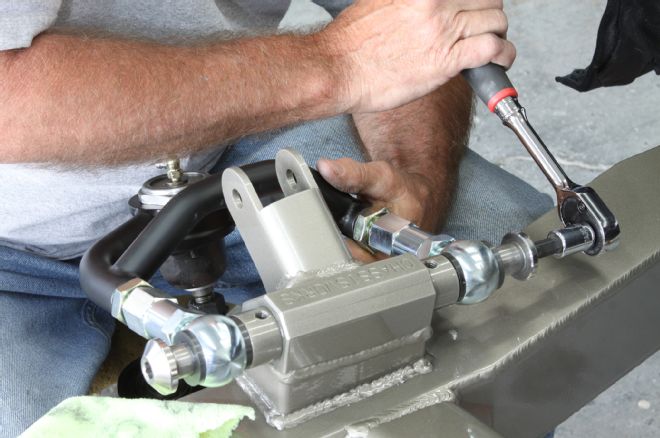
07. The use of CNC-machined billet steel allows Chassisworks to create A-arm mounts with specific areas of increased thickness for added strength. The fixed-axis pivot-pin design eliminates the possibility of shifting pivot shafts, has greater shear strength, and increases bending resistance. The increased rigidity of the design keeps the arm in place and the handling predictable. You can see the one-piece clevis shock mounts, which has an integrated gusset resulting in a smooth look and a stronger mount that won’t flex and cause a possible failure.
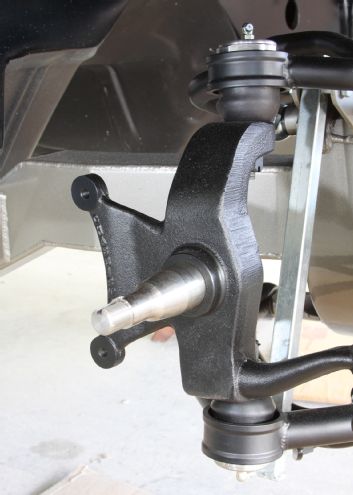
08. Chassisworks’ g-Machine sculpted two-piece spindles features a 2-inch-dropped ride height but are taller than commonly used OEM spindles. This provides a lower center of gravity and quicker camber curve for improved cornering traction. Made from high-strength ductile iron, cast for Chassisworks by a foundry with over 50 years of experience, yields an excellent strength-to-weight ratio. They also used finite element analysis (FEA) software to eliminate stress concentrations for even more durability under hard use. The spindle axles are machined from special high-strength alloy steel (tensile of 150,000 psi) then inserted into the machined upright forming a shrink-fit pressed assembly.
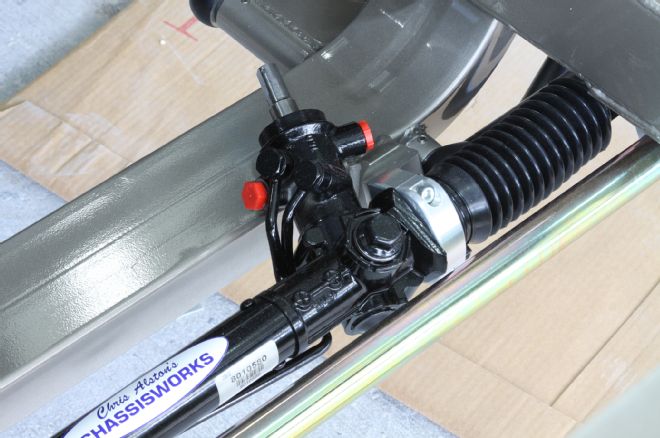
09. Most subframes utilize some sort of reworked OEM rack-and-pinion, but Chassisworks makes their own. This way they are able to dial in the front suspension geometry by ensuring the correct hub-to-hub width. The rack is mounted forward of the axle centerline (i.e., front steer) for more oil pan clearance and the rack can rotate to help eliminate a sharp universal-joint angle and offer a bit more exhaust clearance. The rack is held to the frame by using interlocking billet mounts that won’t flex under hard cornering.
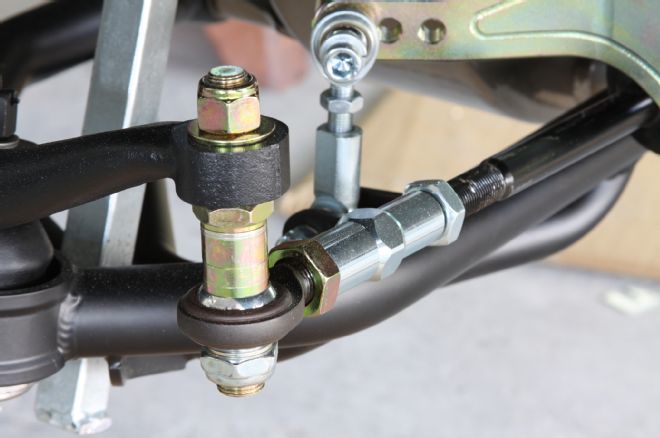
10. One option we went with was Chassisworks’ bump steer kit. This replaced the outer tie-rod with an adjustable billet steel sleeve and high-strength, Teflon-lined 4130 rod end. The tapered Grade 8 stud, along with a selection of shims, will let us vertically adjust the outer pivot point at the steering arms and correct any unwanted toe-in changes during suspension travel. With this kit there should be virtually zero bump steer in 6 inches of suspension travel.
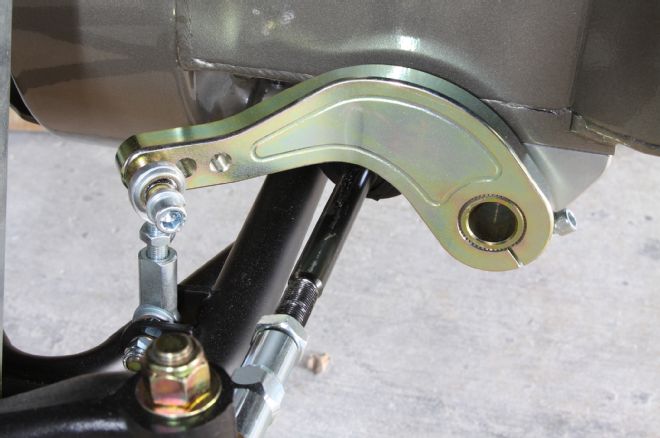
11. Our subframe shipped with Chassisworks’ new splined sway bar option. It’s a 1.25-inch diameter, 33-inch long gun-drilled bar, and we were pretty impressed with the bar and the hardware, especially the zinc-plated billet steel lever arms, which incorporates multiple endlink mounting holes. Teflon race, spherical-bearing endlink assemblies create deflection-free pivot points and help the bar react quicker and be more predictable. Endlink length is also adjustable to eliminate, or add, static preload.
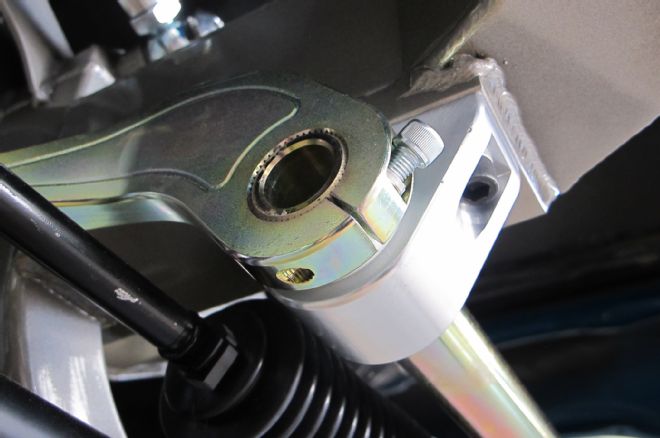
12. The bar was mounted to the frame with billet aluminum bearing housings and 3/8-inch socket-head bolts. The low-friction bearings will allow the bar to pivot freely without introducing off-axis free play.
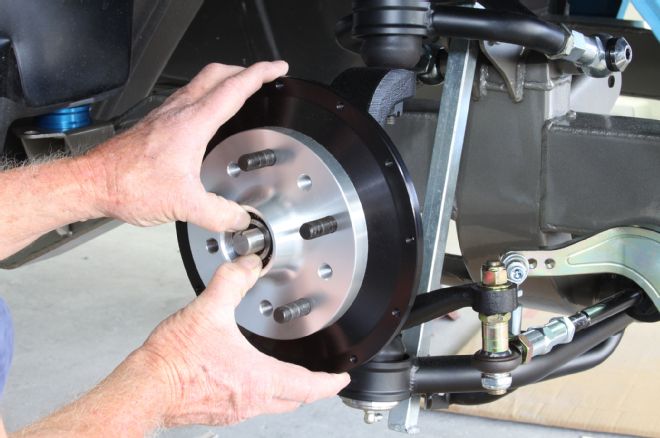
13. The billet aluminum hat and hub assembly helps to reduce weight and allow the individual components to be replaced if they become worn or damaged. The kit also included tapered Timken wheel bearings and 1/2x3-inch wheel studs.
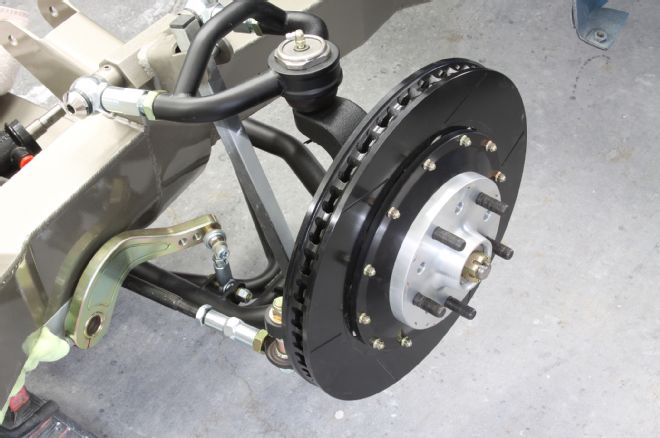
14. To the Chassisworks’ hats we secured the Wilwood 14-inch rotors using the supplied 12-point Grade 8 fasteners. The 1.25-inch thick rotors are directional-vaned, slotted, and finished in Wilwood’s black E-coat. To create more surface area and maximize cooling, 36 individual “I”-shaped passages are cast internally into the rotor. The passages are also curved to increase airflow compared to standard straight-vented rotor designs.
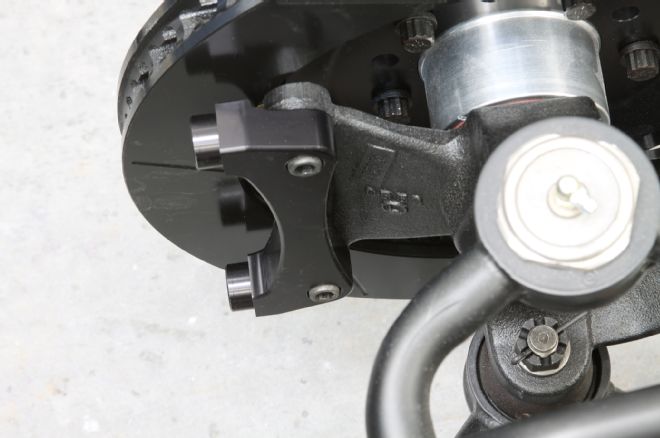
15. The Chassisworks spindles utilize a radial-mount caliper, so the first step in getting the caliper in place was bolting the billet mount to the spindle. Since our Camaro is a long way from hitting the road we didn’t bother installing the six-piston Wilwood calipers yet.
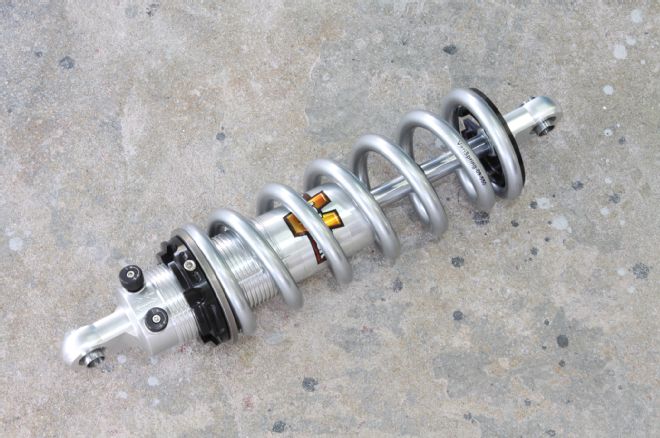
16. When we are ready to roll the Camaro, we’ll be installing these double-adjustable VariShock QuickSet-2 coilovers. They feature sophisticated shock valving with all-new, American-made components. One knob sets bump (compression) while the other sets rebound (extension). Internally, they have Deflective Disk Valving to eliminate spring fatigue, and the piston rods are made from 5/8-inch centerless-ground, hard-chrome steel. The design of the lower ring doesn’t require a locknut, instead it’s locked in place by two ball locks that press into the grooves on the reservoir body. Our starting point for testing will be the 2.5-inch ID, 9-inch long, 550-pound VariSprings.
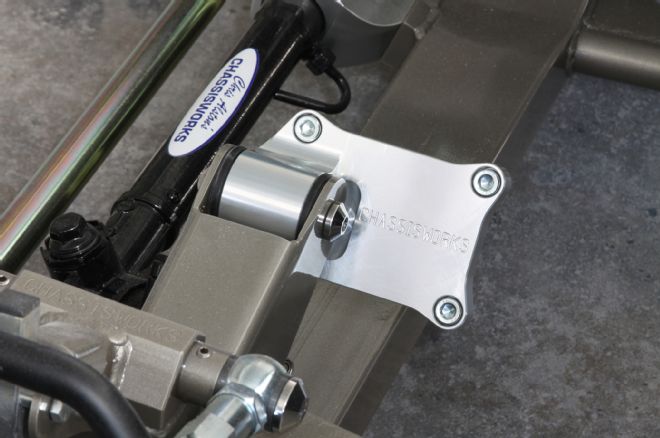
17. With the actual subframe assembled, we were able to check out some of the other features. One that really caught our attention was the super nice billet engine mounts. Most subframes we’ve seen use a two-part deal with an adapter plate bolted to the engine block and, typically, a small-block mount to the frame. For easier engine installation, the passenger-side mount on the frame used slightly oversized slots to account for minor chassis variances. Chassisworks’ subframes also allow for the use of small- or big-block motor plates and mid plates in addition to standard side-mount brackets.